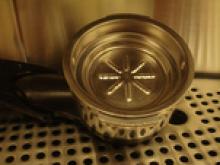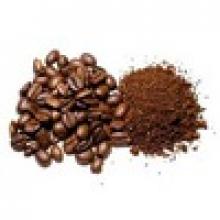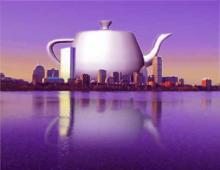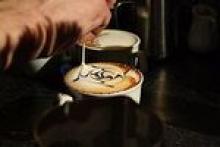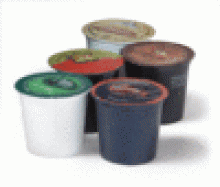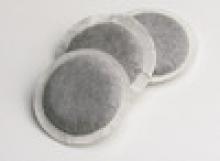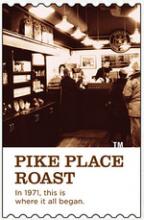The Latest Espresso Tech: The Slayer
At a mere $18,000 The Slayer is not the machine for everyone. In fact, less than 20 of these hand built machines are in use in coffee shops today. What would lead a coffee shop to pay nine or ten times as much for an espresso machine, compared to typical commercial espresso machines? Aside from being absolutely beautiful, The Slayer allows for a degree of customization unheard of in today's espresso marketplace.
The Slayer has a series of wooden paddles which can be adjusted to change the pressure flow from the boiler, which allows the barista to customize their draw to a truly unique extent. As Gizmodo says, this allows you to perform Clever Espresso Tricks like "start with a low pressure extraction, ramp up to full pressure, then back it down to get different textures or flavors." No I don't know why you would want to do that, but I am not a professional barista.
On the down side (or maybe it is an up side to the fanatics) Gizmodo also describes the machine as "finicky," pointing out that it took the latest coffee shop two months to finally master the machine. Now that they have, Gizmodo reporter Matt Buchanan swears that they are producing "some of the best espresso shots in New York."
Still though, that two month learning curve would be enough to give any business owner pause! Espresso has gone from an elite skill to something more akin to "fast food technician." And I say that as someone who worked for several years as a bar back at a small locally owned espresso café in Seattle. More customization means more chances to screw up the coffee, and since there isn't a certification program for baristas, if you're a business owner you want your espresso machine to be as simple (i.e. foolproof) as possible.
This after all is why Starbucks and many other small coffee shops have gone to push-button machines that literally anyone can operate. (Not that they can't still screw it up. If you live outside a major metropolitan area as I do, you have two choices for on-the-go espresso: Starbucks, and those little parking lot coffee huts that specialize in weird flavors like "Snickers mocha" and "white chocolate raspberry latte." I have gone to many of these, wanting to spend my money with small businesses, and not once have I received a drink without an error. And it's not like my orders are so complicated! Last time I tried a local coffee stand I ordered a tall no-whip mocha. It came with whip.)
Err… what was I saying? Oh right, the Slayer. This is obviously beyond "the Cadillac of espresso machines." It puts me in mind of the Russian diamond-encrusted SUV that you can have customized with whale penis leather interior. Like, I'd really love it if YOU bought one, but I never will!
Creative Commons-licensed photo courtesy of Flickr user YaelBeeri
Burnt Coffee - In A Good Way!
The inventor found a way to collect, dry, and compress coffee grounds into a fire log. At about $3.50 per log, Java-Logs are comparable in price to their competitors like Presto-Logs. And they are unquestionably better for the environment.
The very existence of the Java-Log brings up an excellent point, which is that our national obsession with coffee has a significant ecological footprint. Not only in the agriculture side, but on the waste side as well. Here in the Pacific Northwest at least it is common for Starbucks and other coffee stores to bag up their old grounds and set them beside the front door, free to anyone who wants them. But I wonder, how many people do?
Personally I compost all of my coffee grounds, but I'm fortunate to live on property where I can keep a compost pile. I know that coffee grounds are a popular addition straight to the garden here in the Northwest, because they repel slugs. (They really do - I've run tests. The slugs won't cross a barrier of coffee grounds, most likely because of the acidity.)
Several major cities have composting or green waste programs, which can handle coffee grounds nicely. Coffee grounds compost well, and are a great soil amendment! But what about the rest? A lot of coffee shops have no choice but to throw their used coffee grounds straight into the trash.
Java-Logs currently divert 12 million pounds of coffee grounds from the landfill each year, and even accounting for the usual marketing hyperbole, that's a pretty staggering number. Especially when you consider that this must be only a small fraction of the coffee grounds going to the landfill across the country every year!
The idea of Java-Logs got me thinking. If coffee grounds have that many BTUs compared to wood, then couldn't they be used for even more than a simple decorative fire? It turns out that the answer is yes, and a lot of clever people are working on creating biofuels from coffee.
What gives spent coffee grounds their great energy release possibilities is the oil which is leftover from the coffee bean. According to this Fast Company article, "spent coffee grounds have around 11% to 20% of oil remaining inside. That figure compares well with more useful biofuels like palm, rapeseed and soybeans."
As fanciful as it might sound to drop your used coffee filter into your gas tank, naturally the grounds have to be prepped to become biofuel. This process extracts the oil from the waste grounds (so I guess the waste of the waste grounds has to be composted somehow?) which can then be used the same as diesel.
Imagine the boon for independent coffee houses if they could sell off their waste grounds to be used in biodiesel. Maybe some day your cup of coffee will be subsidized by a biodiesel firm!
National Hot Tea Month
Hot tea is delicious; if for no other reason, enjoy a cup for this one! I add nothing to my tea (whether black or green, fruit flavored or Earl Grey) but a nice dollop of honey; others like cream and sugar, cinnamon sticks, sprinkled spices and plenty of other additives for a nice kick.
From almond to chocolate mint, you can pretty much make any tea into a delicious treat—or even a dessert. And whether it’s Amaretto or bourbon, the addition of alcohol can make one tasty tea cocktail as well. Some even enjoy a nice hot toddy while under the weather. Remember, the longer your tea steeps the stronger it will be.
But January’s celebration of hot tea extends far beyond the palette. Hot tea comes with a variety of health benefits that are sure to make it even that much more enticing.
Women who drink hot tea are 60% less likely to develop arthritis; in fact, tea has been linked to preventing plenty of health problems, such as Parkinson’s disease, cancer, and even cavities.
Depending on the variety, tea may also help stop cancer growth, prevent cancer in general, fight the flu, increase bone density, decrease the risk of a heart attack or stroke, lower cholesterol, soothe strep throat, fight bad breath, and control blood pressure.
That said, drinking very hot beverages may be linked to esophageal cancer; always allow a hot drink to cool a bit before enjoying it. You’ll save yourself from a burned tongue, too. The recommended amount of tea to drink for the benefits listed above is three to five cups daily.
Here are just a few other ways to enjoy a good cup of hot tea.
Add lemon. While you might be avoiding this additive at restaurants where it’s caught a bad rap, you can always cleanly slice your own at home and steep it in your brew.
Add something spicy, like red hots or cayenne pepper.
Use a different sweetener, such as maple syrup or brown sugar.
Top it off with some whipped cream and sprinkles, like nutmeg or cinnamon. Top with nuts if you like.
Stir in your favorite coffee creamer, such as French Vanilla or hazelnut.
Use a fruit syrup flavor, like blackberry or raspberry. If you have a snow cone machine, try some of those flavors.
Add some mint leaves for a burst of fresh flavor. If you don’t have any on hand, use a leftover candy cane from Christmas.
National Gourmet Coffee Month
Whether you’re like Garfield and you can’t start your day without a cup of joe or you simply like to savor the flavor of cup of coffee while out with friends, there’s no excuse to get a cup like Gourmet Coffee Month. Here are a few ways to celebrate.
Splurge: Once a week go for the gold and order the best coffee your neighborhood shop has to offer.
Use Those Gift Cards! That’s certainly what I’ve been doing. I’ve been choosing a different variety each day and have been enjoying the ride. Tip: Order a small if it’s a flavor you haven’t tried yet. I’ve had a couple of large coffees that I didn’t enjoy so much.
Make a Coffee Playdate: Organize a day out with the girls, a coffeehouse performance (music? comedy? poetry?), or just go out alone to a coffee shop and sip a cup as you read, write, or dream.
Get Coffee Crafty: Bring home some toppings (whip cream, caramel, chocolate syrup, cinnamon…) and try making your own concoctions. See what kinds of barista art you can come up with.
Host a Coffee Tasting: If you’ve ever held a wine tasting event at your home or place of business, you know how much fun it can be. Since it’s so cold out in many places right now, why not host a coffee tasting event? Have everyone bring their favorite brew and take turns brewing it in your pot; if people are willing to bring their own percolators, all the better. You could also bake some treats for the event—either beforehand or together as an activity.
Join a Flavor of the Month Club: There are dozens to choose from. Try the Café Connection, Clubs of America, Nectar of Life, or simply search for “Coffee Month Clubs” to find your favorite.
Add a Side: If you already splurge on gourmet coffee regularly, try a muffin, cookie, or scone that you’ve never had before—or upgrade your coffee to a large.
Try Grounding Your Own: My favorite aisle at the supermarket is always the one with so many varieties of coffee beans. Though I buy mine already ground like many people, I always wonder what it would be like to grind my own coffee; the smell is simply heavenly. If there are any people out there who grind their own and want to share some tips, post them here at Latte Talk!
Green Mountain Loses Its Eco Cred With K-Cup
In fact, Green Mountain is one of the consistently highest rated coffees. The company's flagship coffee is their mocha java, which gets a score of 91 points on the Coffee Review website. (And those people are tough graders!) Other blends rate even higher, particularly their fair trade blends. As a bonus, Green Mountain will ship you green coffee beans, and let you roast your own. I had one office mate who roasted his own coffee using a collection of air pop popcorn poppers, and another who used one of those hand crank stovetop poppers.
Regardless, Green Mountain has always positioned itself as fair trade friendly and ecologically conscientious. They heavily promote their fair trade blends, and tout the compostable coffee cup that they developed with a paper company.
However, Green Mountain is no longer a small, feisty, lovable scamp. In 2006 Green Mountain purchased Keurig, makers of the K-Cup coffee system. Green Mountain's earnings have skyrocketed ever since, and it seems fair to call them a "behemoth" now, nipping at the heels of that famed 500 pound gorilla, Starbucks.
The problem? Keurig's K-Cup system is a countertop environmental catastrophe. Coffee's carbon footprint and ecological impact is one thing (something that shade grown and fair trade blends hope to correct). But at least coffee grounds and paper filters are compostable. Many people don't compost them, but they COULD.
Enter the K-Cup, which creates a big ol' wad of plastic waste for EVERY SINGLE CUP OF COFFEE. This is even worse than the pod system espresso makers - at least the pods are compostable. They are ridiculously expensive compared to regular old espresso grounds, and I'm not sure if the foil packets are recyclable, but still. At least it isn't generating a little plastic cup and lid for every single cup!
Every single cup!
I just had to say that again.
I was horrified when I first encountered the K-Cup system. I studied it, convinced that I must have been misunderstanding what I saw. Was it really one individually wrapped plastic container per cup of coffee? That couldn't be right, could it? Oh but it was right.
The K-Cup system is a waste in every possible sense of the word. It's a waste of money, a waste of landfill space, and a waste of petroleum used to make the plastic. All in the name of a tiny bit more ease of use. Look, I'm not a fan of the pre-packaged plastic packets of ground coffee that most offices receive, where you have to open a new packet every time you make a pot of coffee. That's an awful lot of waste that could be replaced with a refillable tub and a measured scoop. But at least those are one packet per pot! It seems downright parsimonious compared to the waste of the K-Cup.
Making Real Hot Chocolate
If you love hot cocoa but you’d really like to try some hot chocolate this season, it’s the perfect time to make some! It’s surprisingly easy to make if you want to make it at home; of course, you can order it at your favorite restaurant if they serve it as well.
To make a big pot of hot chocolate to share with your friends and family (feel free to adjust if it’s just for the two of you), gather together a cup of sugar, 8 cups of milk, 6 ounces of bittersweet chocolate, and a teaspoon of vanilla extract.
Using a good knife, place the chocolate (squares or a bar form work well) on a cutting board or other safe surface and chop it up into fine pieces. The finer the better—it will melt faster that way—but don’t stress over getting the tiniest pieces possible. Scrape them up and put them into a mixing bowl.
Next, pour your milk into a pan and heat it on the stove over medium-low heat. You don’t want it to boil, but do make it hot enough to steam.
Pour your cup of sugar and teaspoon of vanilla into the milk. Stir this up until the sugar dissolves; once it has, turn off the heat. Pour a cup of the mixture (using a ladle works well) onto the chocolate in the mixing bowl, taking care to allow the chocolate to melt slowly. Stir it up with a whisk, turning the chocolate over and making sure all of it is coated with the milk mixture.
Keep slowly adding your milk and mixing until your entire pot of milk is gone and you have a delicious-looking chocolate product left, and immediately serve in the coziest mugs you’ve got!
If you want more of a thick, dessert-like hot chocolate, try this more involved recipe for four:
You’ll need a half cup of milk, a half cup of heavy cream, 2 ounces of bittersweet chocolate, 2 ounces of sugar, 5 egg yolks and a tablespoon of white crème de cacao.
Chop your chocolate up like you would for the recipe above, and instead of the milk, allow the cream to heat on the stove. Unlike the milk, bring it to a boil. Then pour it slowly over the chocolate like you would for the recipe above; only keep half of it warm on the stove.
Next, whisk your egg yolks and sugar together. Once blended, add a scoop of the cream left on the stove into the mix, and quickly whisk it all together. Now add this mixture back into the pot with the remaining cream as you continue to whisk it. Now stir this mixture over low heat for about 20 minutes, allowing it to thicken. Stir the entire time. Once you can run your spoon through the mixture and it parts without running through the open part, it’s ready to use.
Add the rest of your ingredients, as well as the melted chocolate, and keep stirring until it’s cooled off and ready to serve—with a spoon!
Coffee Pods
The only possible application I can see for a pod system is in an office environment. In fact I once worked at an office that had a pod style espresso maker. It was great for a few weeks, but then we ran out of pods, and the company we originally contracted with to deliver fresh pods every week went out of business. So we were stuck with a proprietary system (I forget which one) which would not take any other kind of pods. Not that we didn't try.
At one point we found a source for the pods over the internet. I and a coworker went halfsies on a purchase, because the website sold only institutional sized orders. We received our pods, each carefully wrapped in gold foil, and ended up having to stash them in our desks. Not because our coworkers would specifically steal them, just because people would have assumed that the company had somehow managed to set up delivery services again. Our pods would have been gone within the day.
As it was, we ended up not really using them after all. If you went into the kitchen and started making an espresso, ears would perk up across the floor at the sound of water being pumped through the boiler. People would come running, assuming that the pods were back, and you would have to explain "Sorry, I bought these myself."
I guess you could say I have some baggage with regards to pods. At any rate, I didn't think that the coffee was that great. In fact I assume that in order to keep the cost of the pods even remotely reasonable, the pod companies are virtually forced to use crap coffee in their pods.
I started thinking about all this today when I ran across this DIY post on how to make your own coffee pods. The fine folks at INeedCoffee.com have figured out how to smash coffee into a regular coffee filter, using an empty vitamin bottle and a metal scoop. With several minutes of fiddling, and presumably a learning curve that involves a lot of spilled coffee, and then extreme caution to get the pod into your coffee maker without dumping it on the counter - presto! Your very own pod!
About fifteen years ago, I bought a $50 Hoover vacuum cleaner at Target. It required vacuum cleaner bags (they all did, back then) which cost $6 apiece. I have cats, so I went through about six vacuum cleaner bags per year. At one point I did the math and realized that I had paid almost $600 for that $50 vacuum cleaner! Pod espresso makers are the same way.
If you have a pod espresso maker, I certainly recommend that you check out that post on making your own pods. And seriously think about replacing it with a regular espresso maker, or even just a French press!
Girls of the Bikini Baristas Talk
Hello,
My name is Holly, and I am a student at the Univeristy of Washington. I work at one of the Barista shops in my spare time outside of the city, and we receive a lot of customers and repeat customers. Because I am well-organized and bring a lot of customers back to our stand, the manager has made me a supervisor, and I help he and his wife with many of the clerical tasks that the business has.
Please blog me with any questions that you might have about being a Barista, or what our job is about.
Starbucks "Pike Place Roast" Review
Thus it was with great excitement that I had to read the sign at Starbucks twice. "Pike Place Roast, $10.95 per pound" it read. This was not in one of the prominent displays, but in a knee-high barrel display off to the side of the barista's counter. $10.95 per pound! That makes this blend competitive with several store brands I have tried, as well as with Pacific Northwest brand Millstone.
I had to snap it up, particularly after spotting the price for my favorites, ouch!
This roast (not a blend, notice, but a roast) is named after their Pike Place Market store. This was the first store Starbucks ever opened, long before Howard Schultz came to helm the company. The Pike Place Market store pre-dates Starbucks' expansion, and pre-dates everything that everyone hates about Starbucks. I first tried Starbucks coffee at the Pike Place Market store in 1990, when (if memory serves) there were only about three Starbucks stores in existence.
This is labeled as a "medium intensity" coffee, a claim which makes me raise an eyebrow skeptically. I would have to taste it side by side with my beloved Italian roast to be sure, but it certainly SEEMED more intense than their Italian or French roasts. It has a bitterness about it that reminds me of their Gold Coast and Yukon blends.
The "Flavor" notes say "subtle notes of cocoa and nuts," and I would have to agree. I'm not in the habit of swishing my coffee around in my mouth before pronouncing it "an insouciant hint of blackberry blended with oak," or insert your own "wine snob" parody here. But after taking a few experimental sips, I can indeed taste cocoa and a little hint of nuttiness.
The weird thing about Pike Place Market roast is the taste I can only describe as "sour." Every office with more than ten employees has one employee who likes to brew the office coffee "extra strong." Rather than making BETTER coffee (say, by bringing in a decent roast), this person will proceed to simply double down on the coffee which the office provides. Perfectly understandable - who wants to brew Italian roast for thirty people, most of whom wouldn't pour their coffee on you if you were on fire?
However, it is a mistake to assume that "I used twice as many grounds" is the same thing as "I made it better." A very big mistake indeed. And you know that mistake as soon as you take a sip. You hardly need to ask whether Jim made this batch of coffee; the answer is patently obvious.
That's what Pike Place Roast tastes like. Which is a little mysterious, since it is an effect achieved with the normal amount of coffee. Something about the combination of beans (Starbucks doesn't specify which beans they use for this roast) and the roast results in something… not good.
Not to look a gift horse in the mouth, but you'd be better off buying a good Millstone blend. Sad to say, because I was hoping I had found a real bargain! Now I'm just stuck drinking the rest of the pound before I can justify buying something better. Sigh.

